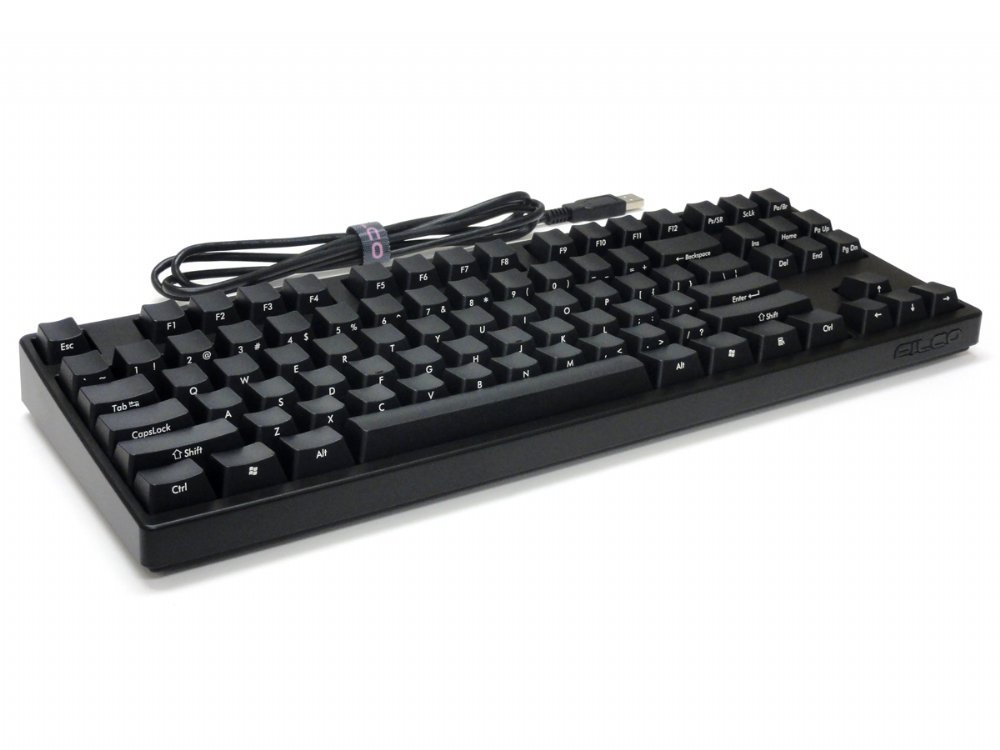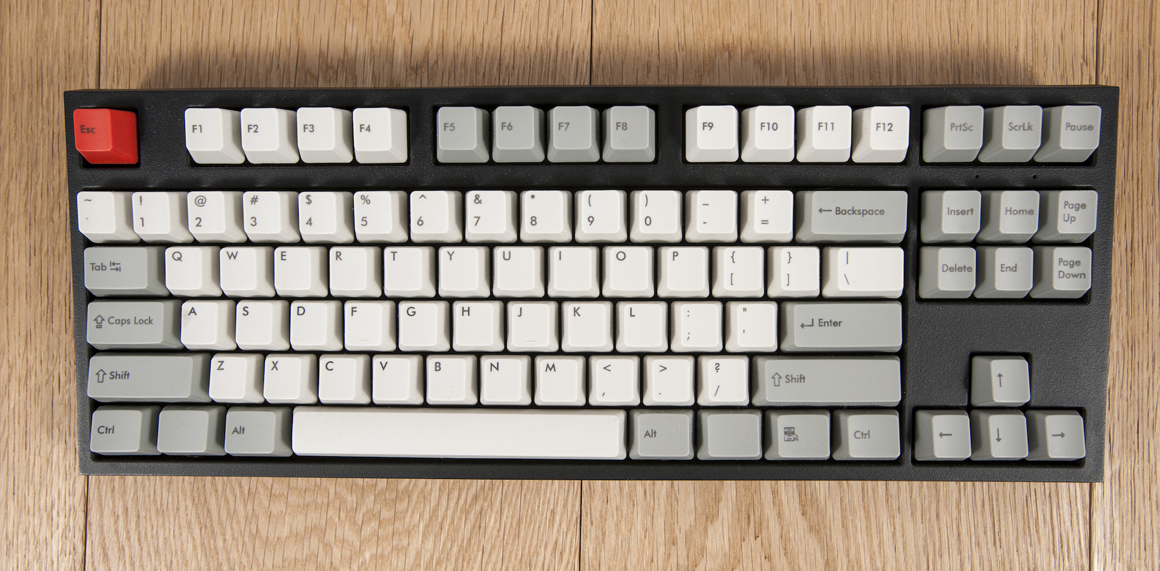What is a mechanical keyboard?
Mechanical keyboards are high quality keyboards that use physical switches for key actuation. For many the greatest improvement that comes with using a mechanical keyboard is the feeling. Typical rubber membrane keyboards require you to push the keys to the bottom to actuate and the required force can be tiring over long periods of typing. Mechanical switches such as Cherry MX have the benefit of actuating partway through the keystroke. Mechanical switches come in many varieties, differing in the amount of force required to actuate as well as the auditory and tactile feedback. Mechanical switches are commonly differentiated by the colour of the slider.
It should be noted that mechanical keyboards are not for everyone and there is no single best switch. They can also be quite expensive. There are only personal preferences. Any keyswitch can work just fine for both typing and gaming. If you haven't used a mechanical keyboard before, it is highly recommended that you visit a local electronics retailer to try out some mechanical keyboards on display.
Switches
The force required to actuate a mechanical switch is given in centinewtons (cN). One centinewton is roughly equal to one gram, which is why actuation weights are sometimes referred to in grams.
Mechanical switches come in many varieties from different companies. The best known mechanical switches are the Cherry MX line of keyswitches, which were introduced in 1983. Cherry MX and similar clones (also sometimes referred to as MX-compatible) are the most common type of mechanical switch. Cherry MX clones generally follow the same colour scheme. Some of the most common Cherry MX clones are Gateron, Kailh and Greetech switches.
Cherry MX
Cherry MX Black (linear; 60 cN actuation force)
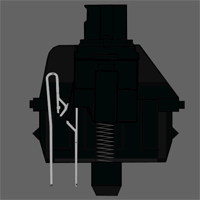
Cherry MX Black is a relatively heavy linear keyswitch. High actuation force combined with the lack of tactile feedback can make typing with MX Black switches feel uncomfortable and tiring. Most commonly found in Cherry's G80 line of keyboards and some gaming keyboards.
Cherry MX Blue (tactile; clicky; 50 cN actuation force)

Commonly characterized as the switch for typing, Cherry MX Blue has both a tactile bump and audible click. The MX Blue has a white inner slider which creates the click sound as it hits the bottom of the switch housing.
Cherry MX Brown (tactile; 45 cN actuation force)
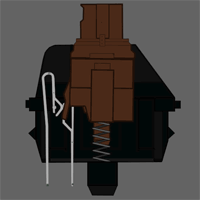
Cherry MX Brown is possibly the most common mechanical switch found in keyboards. MX Brown is a light tactile switch without the audible feedback. Due to the low actuation force, the tactile point is much less pronounced than other tactile Cherry MX switches.
Cherry MX Clear (tactile; 55 cN actuation force)

Cherry MX Clear is similar to MX Brown in that it is a tactile switch without audible feedback. MX Clear actuates at 55 cN, with the tactile feedback peaking at force of 65 cN. Following the tactile bump, the force required to push the key raises sharply, to a peak of 95 cN at the bottom of the keystroke. In essence, it is a heavier, more tactile version of MX Brown. Like the MX Black, the large amount of force required by the switch can be tiring.
Cherry MX Red (linear; 45 cN actuation force)
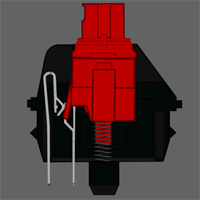
Commonly marketed as a gaming switch, Cherry MX Red is a lighter version of the MX Black. The light linear feel is preferred by many gamers, as it makes double tapping of keys easier compared to other Cherry MX switches. The light actuation weight combined with lack of tactile feedback can make typing feel uncomfortable.
There are many more varieties of Cherry MX switches. For more information, see the article on Deskthority Wiki.
Alps

Like Cherry MX, Alps switches also come in tactile, linear, and clicky varieties. Originally manufactured by Alps Electric and Forward Electronics, Alps switches are relatively uncommon line of keyswitches. While they can be found in many vintage keyboards, they are still manufactured by Matias Corporation and available in many mechanical keyboards from Matias and KBParadise.
For more information on Alps switches, see the Alps SKCL/SKCM series and Alps clone articles on Deskthority Wiki.
Logitech Romer-G

Manufactured by Omron for Logitech, Romer-G switches are a light tactile switch with 45 g actuation force. Romer-G switches are most similar to Cherry MX Brown in feel. Romer-G switches have a unique light pipe that allows for improved backlighting with less light leakage.
For more information on Logitech Romer-G switches, see the article on Deskthority Wiki.
Topre

Manufactured by Topre Corporation, Topre switches are electorstatic capacitive non-contact switches. The switches consist of a slider over a rubber dome over a spring. When a switch is pressed, a capacitative sensing mechanism detects the keypress mid-actuation. Topre switches are rare and expensive. They come in various weights and can be found in keyboards by Topre, PFU Limited, and Leopold.
Topre switches are controversial in the mechanical keyboard community, as they are considered by some to feel alike or similar to conventional rubber dome keyboards.
For more information on Topre switches, see the article on Deskthority Wiki.
Layouts
There are many keyboard layouts in use today, but this part will cover the two most common layouts.
ANSI

ANSI layout is based on the American National Standards Institute's ANSI/HFES 100 standard. Variants of it are used in North America and Asia.
ISO

ISO layout is based on the International Organization for Standardization's ISO 9241 standard. Variants of it are used in Europe.
Form Factors
Beyond the conventional full size keyboard with numeric keypad, there are many other form factors available. Many form factors are commonly referred to by percentages. Smaller form factors are considered by some to be more ergonomic as they allow for the mouse to be kept within easier reach. Listed here are some of the more common alternative form factors.
Tenkeyless

Tenkeyless, sometimes referred to as TKL, is a keyboard that has no numeric keypad. The name comes from another name for the numeric keypad, tenkey. Hence tenkeyless.
75%

The 75% design reduces the navigation cluster to one column on the right of backspace and enter while retaining the function keys. This layout is common on laptop keyboards.
60%

The 60% design omits the numeric keypad, navigation cluster and the function key row. The escape key is moved to the number row. Access to function and navigation keys is usually implemented with one or more function keys.
Resources
Deskthority Wiki - The largest English language wiki on mechanical keyboards. Excellent resource for information on different types of mechanical keyswitches.
Deskthority Forum - Europe-based mechanical keyboard forum, home to some of the biggest keyboard collectors in the community.
Geekhack Forum - US-based mechanical keyboard forum. Largest and most active traditional forum on mechanical keyboards.
Mechanical Keyboards Subreddit - The most active mechanical keyboard community, content consists mostly of picture posts of users keyboards.
Mechanical keyboards are high quality keyboards that use physical switches for key actuation. For many the greatest improvement that comes with using a mechanical keyboard is the feeling. Typical rubber membrane keyboards require you to push the keys to the bottom to actuate and the required force can be tiring over long periods of typing. Mechanical switches such as Cherry MX have the benefit of actuating partway through the keystroke. Mechanical switches come in many varieties, differing in the amount of force required to actuate as well as the auditory and tactile feedback. Mechanical switches are commonly differentiated by the colour of the slider.
It should be noted that mechanical keyboards are not for everyone and there is no single best switch. They can also be quite expensive. There are only personal preferences. Any keyswitch can work just fine for both typing and gaming. If you haven't used a mechanical keyboard before, it is highly recommended that you visit a local electronics retailer to try out some mechanical keyboards on display.
Switches
The force required to actuate a mechanical switch is given in centinewtons (cN). One centinewton is roughly equal to one gram, which is why actuation weights are sometimes referred to in grams.
Mechanical switches come in many varieties from different companies. The best known mechanical switches are the Cherry MX line of keyswitches, which were introduced in 1983. Cherry MX and similar clones (also sometimes referred to as MX-compatible) are the most common type of mechanical switch. Cherry MX clones generally follow the same colour scheme. Some of the most common Cherry MX clones are Gateron, Kailh and Greetech switches.
Cherry MX
Cherry MX Black (linear; 60 cN actuation force)

Cherry MX Black is a relatively heavy linear keyswitch. High actuation force combined with the lack of tactile feedback can make typing with MX Black switches feel uncomfortable and tiring. Most commonly found in Cherry's G80 line of keyboards and some gaming keyboards.
Cherry MX Blue (tactile; clicky; 50 cN actuation force)

Commonly characterized as the switch for typing, Cherry MX Blue has both a tactile bump and audible click. The MX Blue has a white inner slider which creates the click sound as it hits the bottom of the switch housing.
Cherry MX Brown (tactile; 45 cN actuation force)

Cherry MX Brown is possibly the most common mechanical switch found in keyboards. MX Brown is a light tactile switch without the audible feedback. Due to the low actuation force, the tactile point is much less pronounced than other tactile Cherry MX switches.
Cherry MX Clear (tactile; 55 cN actuation force)

Cherry MX Clear is similar to MX Brown in that it is a tactile switch without audible feedback. MX Clear actuates at 55 cN, with the tactile feedback peaking at force of 65 cN. Following the tactile bump, the force required to push the key raises sharply, to a peak of 95 cN at the bottom of the keystroke. In essence, it is a heavier, more tactile version of MX Brown. Like the MX Black, the large amount of force required by the switch can be tiring.
Cherry MX Red (linear; 45 cN actuation force)

Commonly marketed as a gaming switch, Cherry MX Red is a lighter version of the MX Black. The light linear feel is preferred by many gamers, as it makes double tapping of keys easier compared to other Cherry MX switches. The light actuation weight combined with lack of tactile feedback can make typing feel uncomfortable.
There are many more varieties of Cherry MX switches. For more information, see the article on Deskthority Wiki.
Alps

Like Cherry MX, Alps switches also come in tactile, linear, and clicky varieties. Originally manufactured by Alps Electric and Forward Electronics, Alps switches are relatively uncommon line of keyswitches. While they can be found in many vintage keyboards, they are still manufactured by Matias Corporation and available in many mechanical keyboards from Matias and KBParadise.
For more information on Alps switches, see the Alps SKCL/SKCM series and Alps clone articles on Deskthority Wiki.
Logitech Romer-G

Manufactured by Omron for Logitech, Romer-G switches are a light tactile switch with 45 g actuation force. Romer-G switches are most similar to Cherry MX Brown in feel. Romer-G switches have a unique light pipe that allows for improved backlighting with less light leakage.
For more information on Logitech Romer-G switches, see the article on Deskthority Wiki.
Topre

Manufactured by Topre Corporation, Topre switches are electorstatic capacitive non-contact switches. The switches consist of a slider over a rubber dome over a spring. When a switch is pressed, a capacitative sensing mechanism detects the keypress mid-actuation. Topre switches are rare and expensive. They come in various weights and can be found in keyboards by Topre, PFU Limited, and Leopold.
Topre switches are controversial in the mechanical keyboard community, as they are considered by some to feel alike or similar to conventional rubber dome keyboards.
For more information on Topre switches, see the article on Deskthority Wiki.
Layouts
There are many keyboard layouts in use today, but this part will cover the two most common layouts.
ANSI

ANSI layout is based on the American National Standards Institute's ANSI/HFES 100 standard. Variants of it are used in North America and Asia.
ISO

ISO layout is based on the International Organization for Standardization's ISO 9241 standard. Variants of it are used in Europe.
Form Factors
Beyond the conventional full size keyboard with numeric keypad, there are many other form factors available. Many form factors are commonly referred to by percentages. Smaller form factors are considered by some to be more ergonomic as they allow for the mouse to be kept within easier reach. Listed here are some of the more common alternative form factors.
Tenkeyless

Tenkeyless, sometimes referred to as TKL, is a keyboard that has no numeric keypad. The name comes from another name for the numeric keypad, tenkey. Hence tenkeyless.
75%

The 75% design reduces the navigation cluster to one column on the right of backspace and enter while retaining the function keys. This layout is common on laptop keyboards.
60%

The 60% design omits the numeric keypad, navigation cluster and the function key row. The escape key is moved to the number row. Access to function and navigation keys is usually implemented with one or more function keys.
Resources
Deskthority Wiki - The largest English language wiki on mechanical keyboards. Excellent resource for information on different types of mechanical keyswitches.
Deskthority Forum - Europe-based mechanical keyboard forum, home to some of the biggest keyboard collectors in the community.
Geekhack Forum - US-based mechanical keyboard forum. Largest and most active traditional forum on mechanical keyboards.
Mechanical Keyboards Subreddit - The most active mechanical keyboard community, content consists mostly of picture posts of users keyboards.


